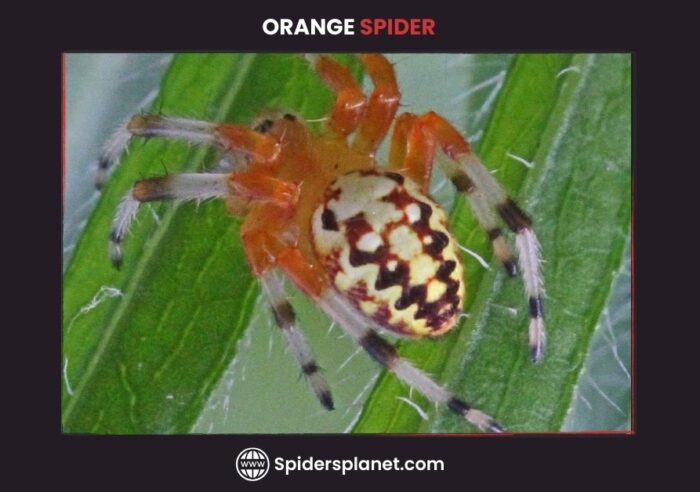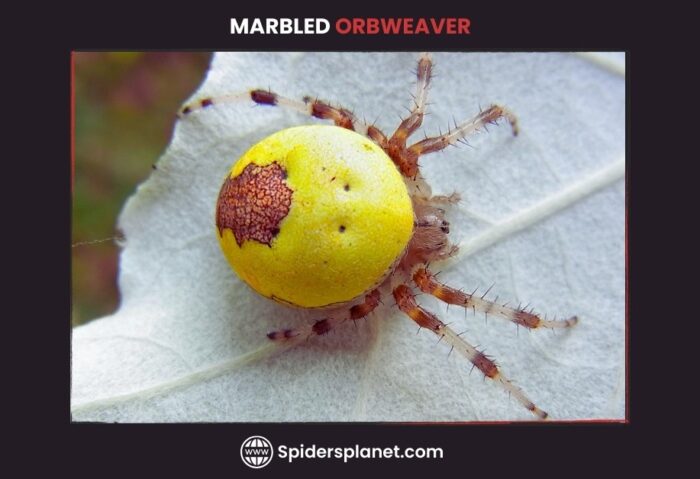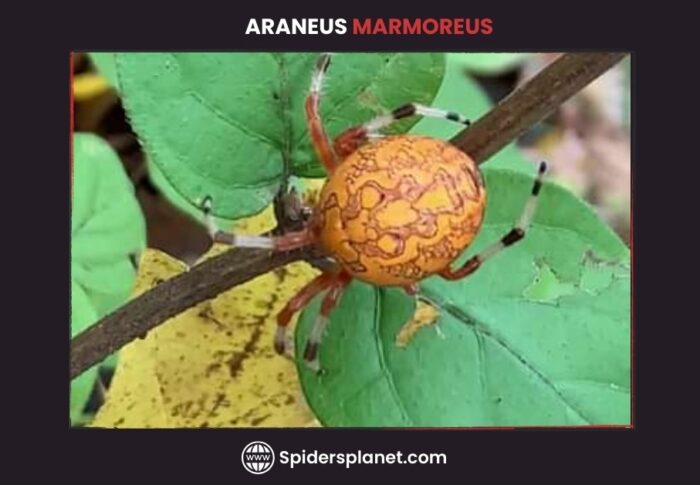In gardens, you will find various Orange spiders, but the one you often come across is the marbled orb weaver, scientifically known as Araneus marmoreus.
People also call it a pumpkin spider because it has a round, puffed-up belly and a bright yellow color. Found commonly in North American gardens, these spiders are skilled predators, using their potent venom to paralyze insects like flies and mosquitoes.
Despite their intimidating appearance, their bites are harmless to humans.
The real magic lies in their delicate webs, spun from silk produced in their abdomens. These spiders spin vertical webs on trees, shrubs, and grasses.
Beyond their aesthetic appeal, these spiders actively capture and consume a variety of insects, helping to naturally manage and reduce pest populations.
Here, we are going to explain and learn everything like its appearance, body, habits and habitat, life cycle, what it wants to eat or hunt, its predators, babies, and more about the life of this little marvel. So let’s start the journey and keep reading ….!
Orange Spider Description:
Scientific Name and Family:
The most common Orange spider, the marbled orb weaver spider, scientifically classified as Araneus marmoreus, belongs to the vast kingdom of Animalia.
It takes its place among the class Arachnida, signifying its eight-legged form. Further down the taxonomic hierarchy, it falls under the order Araneae, representing the diverse and widespread order of spiders.

Specifically, its family is Araneidae, and its genus is Araneus, emphasizing its kinship with other orb-weaving spiders.
The spider, often referred to as the pumpkin spider, gets its nickname because the female’s round belly looks like an orange pumpkin.
Species:
These marbled orb-weaver spiders come in two main types. The first type of Orange spider (Araneus marmoreus) features a bright orange abdomen with black or brown marbling.
In contrast, the second pyramidatus is much lighter, sometimes nearly white, with a single dark patch towards the rear of the abdomen.
The Araneus marmoreus is found everywhere the spider lives, but the Pyramidatus type is mostly in Europe.
They are rarely found together. Pyramidatus is not very common in North America, but you might see it in the northern part of the United States and Canada.
The marbled orb weaver is part of the Araneidae family, which ranks as the third-largest spider family globally, encompassing 3,108 species across 186 genera.
The marbled orb weaver is part of the Araneus group, which has more than 1,500 members all around the world.
Varieties of Orange Spiders: Beyond the Marbled Orb Weaver
The marbled orb weaver is not the only orange spider having vibrant orange hues; several other species share this striking characteristic, including:
- European garden spider — Araneus diadematus
- Woodlouse spider — Dysdera crocata
- Shamrock orb weaver — Araneus Trifolium
- Striped lynx spider — Oxyopes salticus
- Orange baboon tarantula — Pterinochilus murinus
- Spotted orb weaver — Neoscona crucifera
- Arrowhead orb weaver — Verrucosa arenata

Body or Anatomy:
The head and Chest (Cephalothorax) are the spider’s control center, where the brain, fangs, and feelers are.
The spider’s head-chest is usually yellow to burnt orange, with marks that look like a small pumpkin stem.
The strong fangs (Chelicerae)near the front of the head-chest. They have venom to catch and eat prey. Pedipalps act like feelers, helping the spider-sense things.
The spider has eight eyes on top of its head-chest. The Belly (Abdomen) is the most noticeable part, especially in females, and is big and oval-shaped, like a mini pumpkin.
It is bright orange with cool patterns, warning predators. Inside, there is everything for eating, making babies, and spinning silk for webs.
Silk Makers are near the end of the abdomen are six silk makers (Spinnerets). They create strong silk for making webs, homes for eggs, catching prey, and even as a safety line.
The spider has eight legs, long and hairy, for moving around, climbing, and catching food. They’re also handy for trapping and handling caught prey.
Evolution and Historical Background:
In 1757, Swedish entomologist Carl Alexander Clerck described Araneus marmoreus, detailing its characteristics. In the same work, he also introduced the Araneus pyramidatus.
However, further research revealed that Araneus pyramidatus was the same species as Araneus marmoreus. In taxonomy, when two names refer to the same species, one becomes a synonym.
Thus, Araneus pyramidatus is now recognized as a synonym of Araneus marmoreus, signifying they are different names for the same spider.
Appearance:
Size:
Like many spiders, the females are usually two to three times larger than the males and have the most eye-catching look.

Female size can range from 0.35 to 0.7 inches in length and 0.09 to 0.18 inches in width. In comparison, males are smaller, measuring between 0.35 and 0.39 inches long, with a width of 0.09 to 0.1 inches.
Color:
The female marbled orb weavers have bright orange bellies, showing fancy brown, black, or sometimes purple patterns.
Some may even have bodies in pale yellow, white, or black/brown. Their head and thorax (cephalothorax) are usually yellow to burnt orange with dark markings.
Now, the male orb weavers are not as fancy, usually wearing brown or gray with a bit of orange. Their bellies are way smaller than the females.
How to Identify?
Identifying the marbled orb weaver or pumpkin spider is straightforward.
- Females have an oval, vibrant orange, marbled abdomen, while males are smaller with subtle markings.
- Found in wooded areas, meadows, and gardens, they weave vertical orb webs.
- Females are around 18 mm, males about 9 mm.
- Search for webs adorned with morning dew featuring a unique zigzag pattern.
- If you spot a bright Araneus marmoreus during the day, it is likely a female marbled orb weaver.
What They Like to Eat?
The marbled orb weaver is a skilled hunter with a taste for small insects. Flies, mosquitoes, moths, beetles, and other flying bugs make up its diet.
Using its sticky web, the spider senses vibrations when an insect gets caught. It quickly bites and injects venom for smaller prey, wrapping larger ones in silk.
After immobilizing them, it liquefies their insides with digestive enzymes for a nutritious meal. The marbled orb weaver also occasionally enjoys spiders of smaller species, bees, wasps, and small millipedes.
This orange wonder not only helps control the insect population but also savors a diverse and tasty diet.
Habitat: Where Orange Spiders Live?
Araneus marmoreus, known as the orb-weaver spider, is distributed across continental America, eastern Britain, and East and Central Europe, but it has not been spotted in northern Ireland.
Araneus marmoreus, specifically the marbled orb weavers, establish their homes in various natural settings. They can be found in woodlands, where they skillfully spin their webs amidst tall herbaceous vegetation, shrubs, and the lower branches of trees.
Additionally, these spiders inhabit diverse environments, including forests, meadows, agricultural fields, peat bogs, and areas along rivers.
While they may occasionally set up webs in man-made places like mailboxes, they rarely venture indoors.
The name “orb-weaver spider” comes from the distinctive wheel-like shape of their webs, featuring supporting lines as the main framework and silk threads radiating out like spokes from the center.
Upon the capture of prey in the web, vibrations alert the marbled orb weaver to a potential meal.
Behavior:
The marbled orb weaver, or pumpkin spider, is a master of web architecture, creating vertical orbs with sticky and radial threads.
Active at night (nocturnal), they swiftly rebuild their webs and sense vibrations for prey detection.
As patient hunters, they use venomous bites and silk wrapping to immobilize and consume prey.
Solitary for most of their lives, they mate twice a year, and females guard egg sacs until spring hatching.
These spiders play a beneficial role in insect control, sport vibrant orange hues as potential warnings, and, despite their venom, pose no threat to humans.
Habits – Orange Spiders Web:
The marbled orb weaver, or pumpkin spider, constructs its webs in locations such as trees, bushes, and tall grass.
The webs go up and down and have a special thread in the middle that tells the spider when it catches something.
Unlike some other spiders, the pumpkin spider likes to hide in a cozy home made of silk on the side of the web, connected by a special thread.
This home can be made from folded leaves stuck together with silk, just silk, or it might be hidden under leaves and other stuff from nature.
Lifecycle and Reproduction:
During late summer or early fall, they mate as females attract males with pheromones. After a cautious encounter, the male transfers sperm to the female, completing the process swiftly.
The female then weaves silken egg sacs, guarding them diligently throughout winter. Come spring, the eggs hatch, and tiny spiderlings disperse using silk balloons.
Equipped with wind-catching abilities, they find new habitats. Remarkably, female marbled orb weavers, having mated once, exhibit a brief six-month lifespan.
Observing egg sacs in late summer and witnessing spiderlings float away in spring provides a magical glimpse into their lifecycle, contributing to the ecosystem’s balance.
Lifespan:
Marbled orb weavers, despite their vital ecological role, live fast and die young, with an average lifespan of about six to twelve months.
This brief cycle allows for rapid population turnover, ensuring adaptability and resilience in changing environmental conditions, a common trait in the spider world.
Predators:
Spiders, despite being skilled predators themselves, face natural threats from larger arthropods like scorpions, centipedes, and wasps.
These formidable creatures consider spiders a part of their prey. Additionally, birds and certain reptiles are known to include spiders in their diet.
Ecological Importance:
The marbled orb weaver acts as nature’s pest controller, using its intricate webs to capture insects and mitigate the necessity for harmful pesticides, thereby fostering a balanced environment.
It plays a role in the food web, providing prey for other animals and contributing to biodiversity.
Bite and Venom:
Orange spiders, including marbled orb weavers, pose no harm to humans. While they may appear aggressive, their venom is specifically adapted for subduing prey and is not dangerous to humans.
In fact, their venom is comparable in effect to a bee or wasp sting.
Additionally, these spiders typically stay outdoors and do not venture into homes, minimizing encounters with humans.
Rarely encountered, Araneus marmoreus fulfill a useful role by keeping insect numbers in check, ensuring they pose no threat to humans.
Also Read: Do Spiders Feel Pain? Different Scenario Examples
Conclusion with Interesting Facts:
- Araneus marmoreus, including marbled orb weavers, are not harmful to humans, and their venom is comparable to a bee or wasp sting.
- Marbled orb weavers have an average lifespan of about six months, ensuring rapid population turnover and adaptability.
- The marbled orb weaver is a master of web architecture, creating vertical orb webs with sticky and radial threads.
- Active at night, they rebuild webs swiftly and use vibrations to detect prey.
- Solitary for most of their lives, they mate twice a year, and females guard egg sacs until spring hatching.
- Females are around 18 mm, and males are about 9 mm.
- Black or brown marbling pattern on the spider’s abdomen.
- Araneus marmoreus construct vertical webs designed to catch their prey.
FAQs:
Are Orange Spiders Dangerous?
Most orange spiders pose little danger; just admire them from afar.
Do Orange spiders live a long time?
Sadly, their vibrant lives only last around 6 to 12 months.
How big is a marbled orb weaver?
Think pumpkin seed size! That’s how big a marbled orb weaver is. Females are larger, ranging from 0.35 to 0.7 inches, while males are smaller, measuring between 0.35 and 0.39 inches.
What is a Pumpkin spider?
Marbled orb weaver and pumpkin spider are the same friendly arachnid.
How many eyes do orb spiders have?
Orb spiders have 8 eyes.
What is the largest web-building spider in the world?
The Darwin’s bark spider, scientifically known as Caerostris darwini, is an extraordinary orb-weaver spider recognized for crafting the largest known orb webs. These remarkable webs can range from 900 to an astounding 28,000 square centimeters.
When do Orange spiders mate?
Orange spiders, most commonly referred to as the marbled orb weaver, typically mate in late summer or early fall. This allows the females time to lay their eggs before winter chills arrive, ensuring their offspring hatch in spring with warmer temperatures and abundant food sources.




Leave a Reply